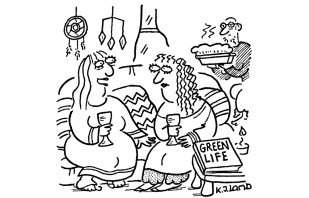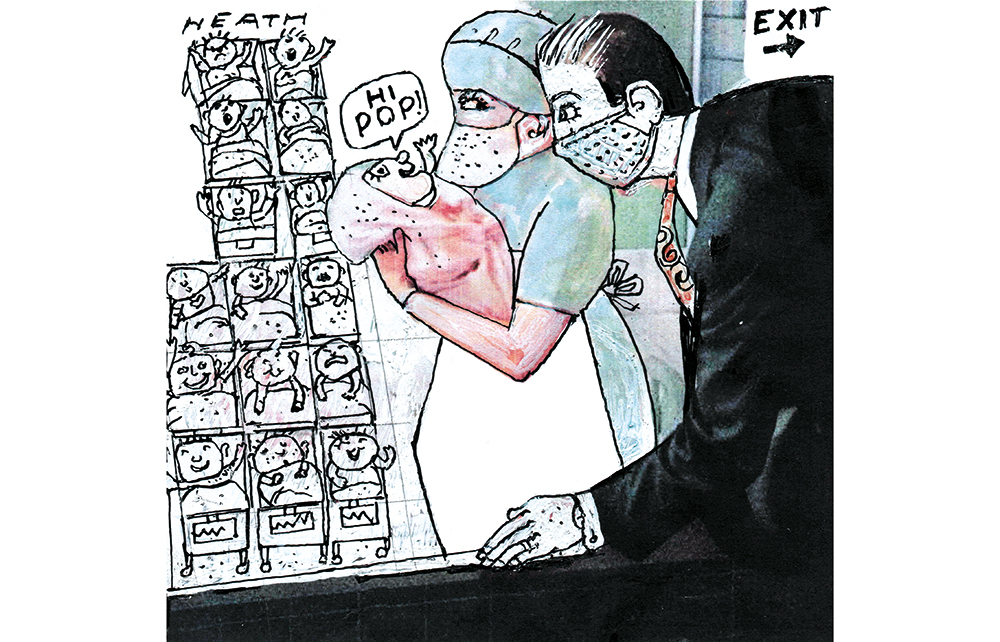‘Hello, my current occupation is police officer,’ says Dex in a thick Danish accent. ‘It seems very adventurous and exciting to do, and to make a difference for the people I meet out in the world.’ Dex is just over 13 stone, around six feet tall, has very fair skin and blue eyes. His favourite animal is the dog. Dex is also a Danish sperm donor, and I’m listening to the beginning of an 11-minute voice-recording on his profile.
On the website of the European Sperm Bank, which bills itself as ‘Europe’s leading sperm bank’ and is based in Copenhagen, there are hundreds of profiles like Dex’s available to British women. Create a free profile and, in under a minute, you can scroll through smiling baby pictures of Danish men as if looking for a new party frock. You also have access to a copy of a handwritten note that can be shown to any future children. ‘I hope that wherever you go, you will touch the ones around you with energy, compassion and love. I truly wish you the best in life,’ signs off Dex.
Why is a small Nordic country more famous for Lego and fibrous bread fathering so many British babies?
The import of Danish sperm into the UK is big business. According to the most recent figures available, in 2020 almost half of all donated sperm used in Britain came from abroad – 27 per cent from America (population: 332 million), and 21 per cent from Denmark (population: six million). Given that more than 28,000 sperm-donor babies have been born in the UK in the past 20 years, this means we have several thousand Vikings among us. Why is a small Nordic country more famous for Lego and fibrous bread fathering so many British babies?
‘Have you ever checked in at the airport next to a flight for Copenhagen?’ asks a friend, who has her own chubby, gurgling Viking toddler thanks to a Danish donor, after she and her wife spent nearly £20,000 on sperm, fertility treatments and drugs. ‘They’re all beautiful.’ But the truth is that it wasn’t the thought of a child who would grow up with milky skin, broad shoulders and the ability to win a longboat competition that drove my friend to Denmark for sperm: it was the shortage in the UK.
Guess how many available donors there are in the UK’s biggest sperm bank? 29. I was so astonished by this paltry number that I rang the London Sperm Bank to check. A wary-sounding employee confirmed that it is correct. For the sake of comparison, there are 679 donors on the European Sperm Bank’s books and 287 from California’s Cryobank, which claims to be America’s biggest.
One of the main reasons often given for the British sperm shortage is a change made to the law in 2005. Since then, all donors must consent to potentially being contacted by any children once they’ve turned 18. In Denmark, men can choose to remain anonymous.
But one London-based embryologist I spoke to disagreed that the law change was a key cause of the British shortage. ‘Anonymity is over anyway, what with the advent of DNA sequencing and ancestry websites,’ she says. ‘We’ve just never had any sort of national campaign to encourage sperm donation. In Denmark, it’s seen as a noble thing to do. But if there’s anything in our media about sperm donation, it’s always some creep in a white van driving around the Midlands offering to do natural insemination.’
The black market for British sperm doesn’t exactly help ‘My wife and I are looking for a donor. AI [artificial insemination] only. No contact after birth. We live in west Wales,’ says a recent post in one Facebook group. ‘Caucasian female seeking AI Caucasian donor. Must have full STI check. Can travel in or just outside County Durham,’ says another left a few days earlier.
In such desperate times, many UK women are looking to the Scandi countries, where sperm donation is much more mainstream. Joanna, 41, has a four-year-old daughter thanks to a Dane. ‘I know about the lack of choice in the UK. British men aren’t required to provide photos of themselves, so I went on the European Sperm Bank website and it felt like the right amount of information.’
The banks there, she says, are ‘sophisticated’ and ‘reassuring’, unlike in Britain, which has very different regulations. In Denmark, a substantial amount of information is available about individual donors. ‘Some [Danish] banks also offer a staff member’s personal written commentary,’ says Joanna, who is speaking under a pseudonym to protect her daughter’s privacy. ‘The staff member had written that the donor I ended up choosing was “the kind of young man you would be very happy for your daughter to bring home”. It made him sound like a very decent, wholesome chap, and these are things that are important if you’re contemplating a time in the future when your child might one day choose to meet them.’
In America, even more is provided – for a higher fee, you can have an expression of the donor’s artistic talents such as a poem or a drawing, and a very specific report on their face, including whether they have attached or detached earlobes.
In the UK, no identifying information can be released until the donor child has reached 18, and on British websites only basic details such as height, weight, ethnicity and hair colour are available. No baby or adult photos, no voice-recordings, no poems and certainly no revelations about earlobes. ‘It’s one of the biggest decisions you’re going to make in life, and you’re being asked by the British sperm banks to do it completely randomly with no sense of the person,’ says Claire, 51, who has a three-year-old daughter also thanks to a Danish donor, and who is also speaking under a pseudonym. The British regulations are particularly nonsensical, she says, given that women in the UK can circumvent them easily by importing sperm from Denmark with much more knowledge about the donor.
Denmark has a plentiful supply of sperm, in large part because Danish men see sperm donation as akin to blood donation. At the best banks, around 5 per cent of men make it through the screening process, but once they do, they can then donate dozens or hundreds of times. In 2020, I made a podcast about egg freezing, covering my own experience of it, and about the industry itself. For one episode, I interviewed a Danish donor. ‘Do you ever think about a child you may have fathered?’ I asked the man whom I called John, desperately trying to wring some emotion from him. ‘No, because it’s not my child, I’m only a donor,’ he told me simply. OK John, I persisted, but was it not a huge time commitment, visiting the clinic multiple times to donate over a period of four years? ‘Well, it was on the way to work,’ he replied with a wry chuckle.
John, like all donors, whether in Denmark or the UK, is under no obligation after that, since donors are not considered legal parents, even if they are contacted by a child once they have turned 18. ‘He commits to making a donation rather than a relationship,’ says Annemette Arndal-Lauritzen, the CEO of the European Sperm Bank. She adds that Danish banks have deliberately made it easy for donors to pop in, like John, on the way to work. ‘They’re nice, light spaces; they’re open from 7 to 7; they don’t share a waiting room with a lot of women waiting for treatment.’
Annemette’s bank offers advanced options to help women decide on donors. These include a face match service, where you can send in a photo of yourself, or a relation, or even a celebrity you like, and they’ll find the closest donor, based on the same face ID technology that most of us use to get into our iPhones. Customers can also spread the cost of payment for their sperm using the Swedish company Klarna. Buy sperm now, pay later! The cost is roughly the same as in the UK – around £1,100 for a single ‘straw’, but most banks recommend buying several, especially if you want a sibling for your child down the line.
The average donor, Annemette says, is 27 and paid £35 per donation. It may not sound much, but, as the British embryologist told me, ‘if you’re a 21-year-old student, doing that three or four times a week and taking £35 tax-free every time, that’s like a job’.
In the UK, donors are subject to a ten-family limit to avoid the possibility that half-siblings could end up together. In Denmark, there’s a 12-family limit within the country itself, but it has become such a global exporter of sperm that one Dane could well father up to six families in Sweden, ten in Portugal, and as many as he likes in America, where there’s no family limit at all. ‘We had a 44-year-old at the clinic in London who didn’t get pregnant,’ says the embryologist, ‘and she called up the sperm bank in Denmark to complain. They told her that the donor already had 52 families around the world.’ Last month, a 41-year-old Dutchman who is thought to have fathered more than 550 children worldwide via various clinics, including Danish ones, was ordered to stop donating by a court in the Hague, and banks that still hold his sperm have been told to destroy it.

The embryologist adds that such cases help to explain the paucity of British sperm banks. Banks here, she explains, aren’t incentivised to operate on the same level as Danish or American ones, because the ten-family limit means they can’t make as much money. ‘The cost for sperm banks comes from recruiting the donor and doing all the screening and counselling. So if you can use that donor many more times, like they do abroad, the profit is higher.’
Nowadays, while clinics such as the European Sperm Bank state in their terms and conditions that neither recipients nor donors should seek one another out before the child turns 18, the internet has made it very easy to find out if a donor has had other children. Claire’s daughter already knows she has ‘diblings’ – donor siblings – in Germany, France, Italy and America, thanks to a Facebook group set up to share information. Claire has shown photos of these children to her daughter, and says it’s lovely that they’re in touch, although she jokes that her daughter wasn’t that interested beyond saying they were ‘pretty babies’.
The few friends of Claire’s who have used British banks, she adds wistfully, have already taken their children to meet their British diblings. ‘Which I’m not able to do. It’s also slightly overwhelming because my daughter has so many diblings. It makes me a bit scared that I made that choice.’






Comments